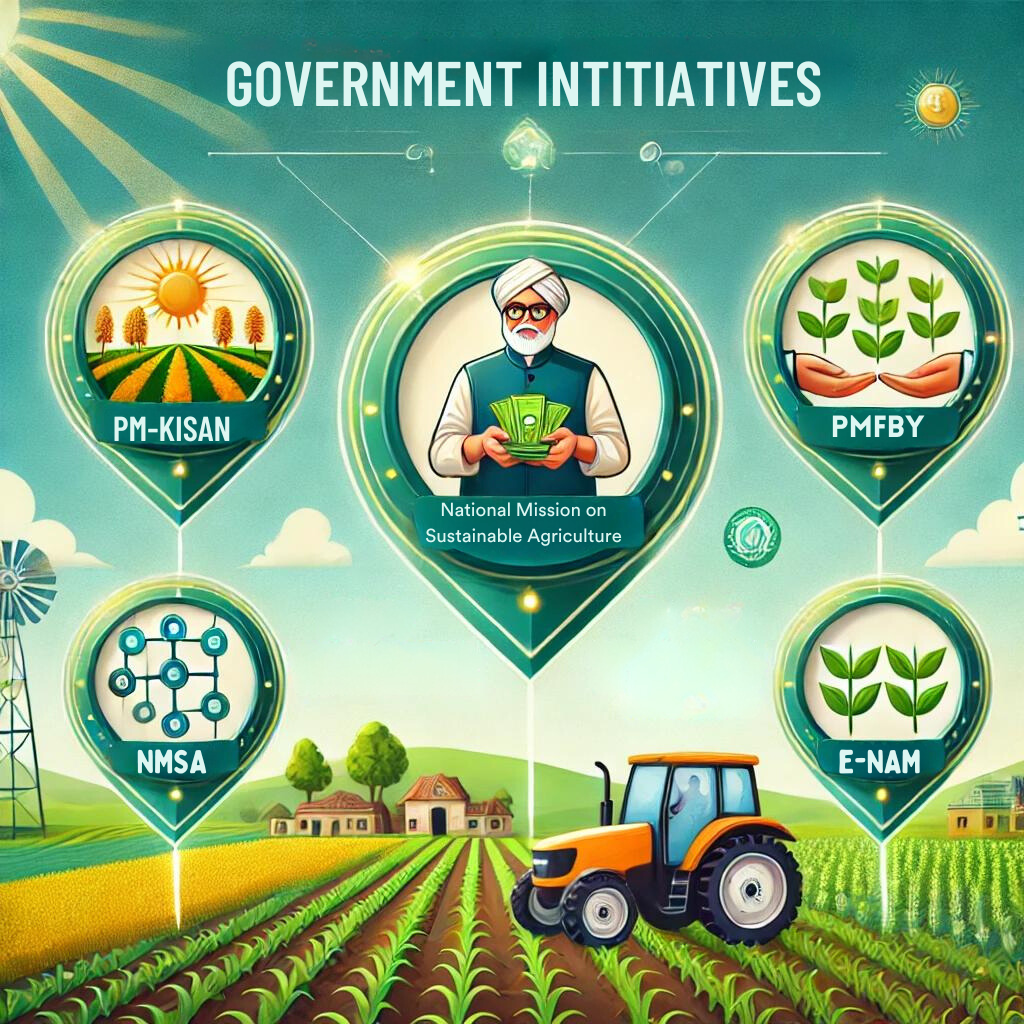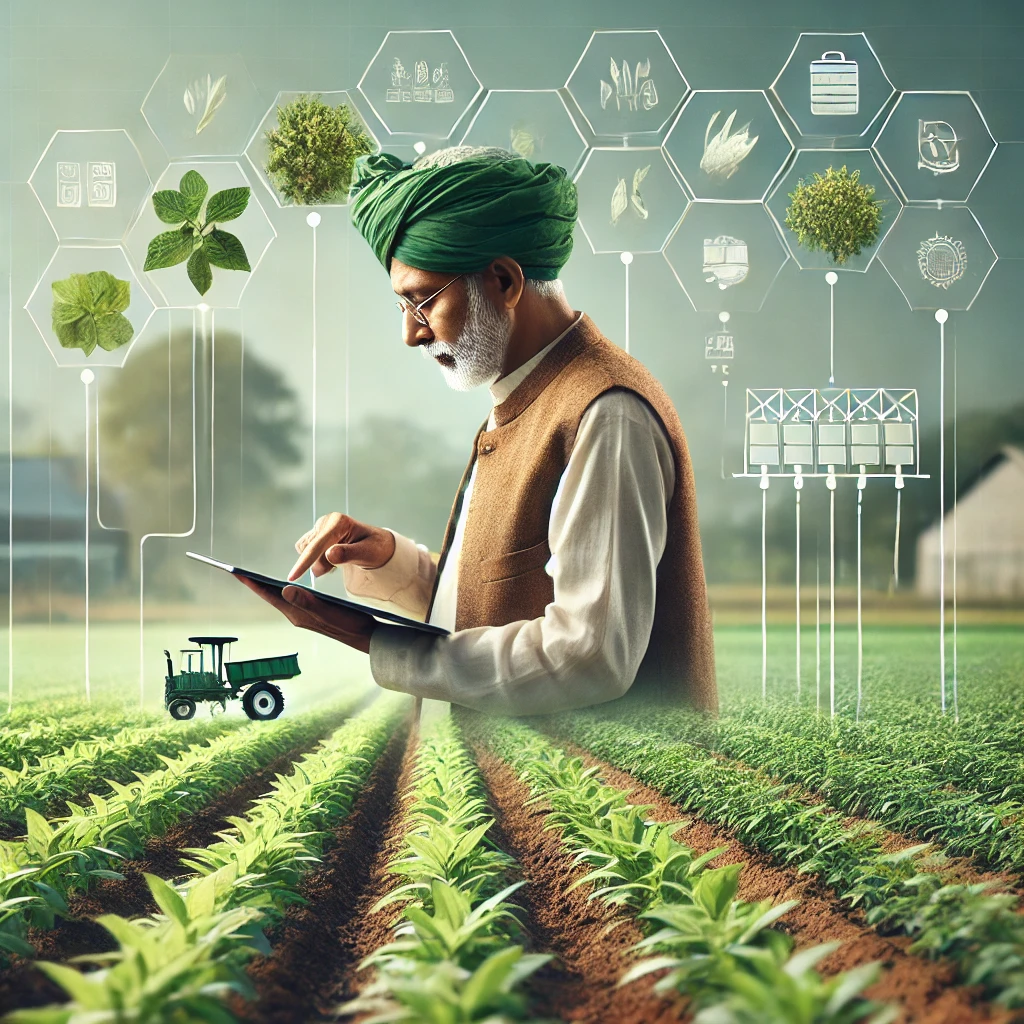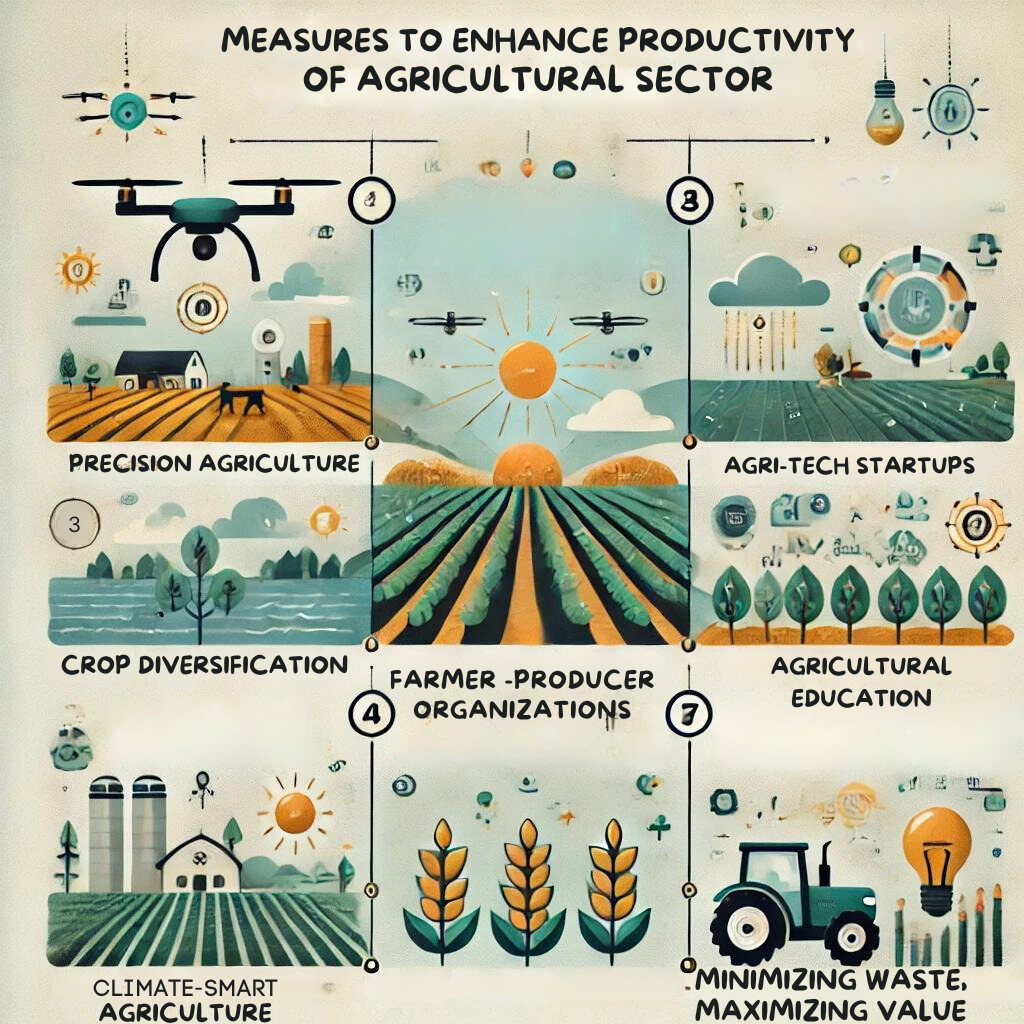Indian agriculture is characterized by low technology and subsistence motives. It has enormous potential for accelerating the pace of economic growth and thereby increasing the rate of employment and income opportunities. But although the sector provides employment to 46% of the workforce and contributes 18% to GDP, the sector has been witnessing erratic growth and ecological challenges. For turning agriculture into an engine of growth, there is an imperative need to address ecological, technological, and institutional barriers. It involves efficient irrigation, crop diversification, and a range of high-tech options involving micro-irrigation and climate-resilient agriculture. It also involves institutional innovations in the form of promoting smallholders’ cooperation through group farming to enhance productivity and farmers’ bargaining power. Indeed, with such changes, Indian agriculture can be made more technology-intensive, ecologically viable, and economically sustainable.
| GS Paper | General Studies III |
| Topics for UPSC Prelims | Indian agriculture sector, Pradhan Mantri Kisan Samman Nidhi (PM-KISAN), Pradhan Mantri Fasal Bima Yojana (PMFBY), Soil Health Card Scheme, Pradhan Mantri Krishi Sinchai Yojana (PMKSY), e-National Agriculture Market (e-NAM), National Mission on Sustainable Agriculture, Paramparagat Krishi Vikas Yojana (PKVY), Digital Agriculture Mission, Unified Farmer Service Platform (UFSP), National e-Governance Plan in Agriculture (NeGP-A), Mission Organic Value Chain Development for North Eastern Region (MOVCDNER) |
| Topics for UPSC Mains | Current Status of the Indian Agriculture Sector, Issues Related to Indian Agriculture Sector. |
Origin of the Article
This editorial is based on “How agriculture can be an engine for growth” which was published in The Indian Express on 04/09/2024. The article highlights how Indian agriculture can drive economic growth by addressing ecological, technological, and institutional challenges.
Relevance for UPSC Students
For UPSC aspirants, understanding the potential of Indian agriculture is crucial. This topic is relevant for GS Paper 3, covering areas like farm subsidies, food security, and agricultural marketing. It enhances knowledge of current issues, government schemes, and technological advancements, aiding in both Prelims and Mains preparation.
Why in News
The focus on transforming Indian agriculture into a growth engine is crucial for UPSC aspirants, as it directly relates to GS Paper 3 topics like agricultural subsidies, food security, and technological advancements. The article’s emphasis on addressing ecological, technological, and institutional challenges aligns with previously asked questions on agricultural productivity, policy reforms, and rural development. Understanding these aspects is vital for aspirants to tackle questions on agriculture’s role in economic growth and sustainability.
Current Status of the Indian Agriculture Sector
Indian agriculture, the backbone of the nation’s economy, has shown remarkable resilience, especially during the pandemic. Contributing significantly to the Gross Value Added (GVA), it employs a large portion of the workforce and has seen record foodgrain production and substantial growth in exports. Recent government initiatives aim to boost productivity and sustainability in the sector.
Economic Contribution
Agriculture and allied sectors contributed 18.8% to India’s GVA in 2021-22, showing robust growth of 3.9% during a challenging pandemic year. This resilience highlights the sector’s critical role in the economy, providing stability when other sectors struggle.
Employment
Despite employing about 42% of India’s workforce, the agriculture sector has seen a declining trend in its employment share, down from 81% in 1983. This shift indicates a gradual movement of the workforce to other sectors, reflecting economic transformation.
Production
In 2021-22, India achieved a record foodgrain production of 315.7 million tonnes, even amidst climate change challenges. This milestone underscores the sector’s potential and the effectiveness of advanced farming techniques and resilient crop varieties.
Exports
Agricultural exports grew by 19.92% in 2021-22, reaching USD 50.21 billion. Major export items include rice, wheat, cotton, and spices, reflecting the global demand for Indian agricultural products and the sector’s export potential.
Organic Farming
India has 7.3 million hectares under organic certification as of 2023-24. This significant area under organic farming indicates a growing shift towards sustainable agricultural practices and the increasing global demand for organic products.
Recent Government Initiatives
The government has launched several initiatives like PM-KISAN, PMFBY, e-NAM, and the National Mission on Sustainable Agriculture. These schemes aim to provide financial support, risk coverage, market access, and sustainable farming practices to enhance the agricultural sector’s productivity and resilience.

Why is Indian Agriculture Underperforming Despite Employing the Majority?
Indian agriculture faces several challenges that hinder its performance despite employing a large portion of the population. Issues such as fragmented land holdings, irrigation challenges, technological lag, market inefficiencies, and policy paralysis contribute to its underperformance.
Fragmented Land Holdings
India’s agricultural land is highly fragmented, with the average farm size decreasing to 1.08 hectares in 2015-16. This fragmentation limits economies of scale, mechanization, and access to credit, reducing productivity and income for small farmers.
Irrigation Challenges in a Changing Climate
India relies heavily on monsoons, with only 52% of cultivated land having access to irrigation as of 2022-23. Inefficient irrigation practices and climate variability, such as recent heatwaves, further exacerbate agricultural productivity challenges.
Technological Lag, Innovation Gap
Despite the Green Revolution, Indian agriculture has struggled to keep pace with modern technologies like precision farming and AI-driven solutions. This lag results in lower yields compared to global standards, highlighting the need for technological advancements.
Market Inefficiencies
The APMC system often leads to exploitation by intermediaries, with farmers receiving only 15-20% of the retail price. While e-NAM aims to create a unified national market, its reach is still limited, affecting market efficiency and farmer income.
Credit Crunch- The Debt Trap
Limited access to formal credit forces many farmers to rely on informal lenders with high interest rates. Over half of India’s agricultural households were in debt in 2019, leading to a cycle of poverty and, in extreme cases, farmer suicides.
Policy Paralysis
Subsidies and the MSP system often distort market dynamics and resource allocation, leading to overproduction of certain crops and environmental degradation. This policy-induced mismatch affects agricultural sustainability and farmers’ incomes.
Post-Harvest Losses
India faces significant post-harvest losses due to inadequate storage and transportation infrastructure. These losses, estimated at ₹92,651 crore annually, lead to distressed sales and reduced income for farmers.
The Knowledge Deficit
A significant skill gap hampers the adoption of modern agricultural practices and technologies. Despite initiatives like PMKVY, the impact on the agricultural sector remains limited, highlighting the need for better training and education.
Diversification Dilemma
Indian agriculture’s focus on staple crops like rice and wheat limits soil health and income potential. High-value crops like fruits and vegetables can increase incomes, but widespread adoption of diversification remains a challenge.
Gender Disparity
Women constitute 42% of the agricultural labor force but own only 14% of the land, affecting access to credit and decision-making power. Empowering women farmers could significantly increase productivity and reduce hunger.

Key Case Studies Related to Agriculture Across the Globe
Examining successful agricultural practices from different countries can provide valuable insights for India. These global examples showcase innovative approaches that enhance productivity and sustainability.
United Kingdom
GrowUp Farms in the UK excels in vertical farming, offering year-round fresh produce in controlled environments. This approach maximizes space use and reduces the environmental footprint, providing a model for urban agriculture.
The Netherlands
The Netherlands utilizes advanced greenhouses with climate control and LED lighting for high-quality vegetable production. The Dutch government also promotes circular agriculture, using biogas energy and recycled materials to enhance sustainability.
China
Zhongguancun Science Park (Z-Park) in Beijing, China, is an innovation hub in areas including bio-medicine. This hub fosters technological advancements and research, providing a model for integrating technology and agriculture.
Measures to Enhance Productivity of Agricultural Sector
To enhance agricultural productivity, India must adopt measures like precision agriculture, crop diversification, FPOs, climate-smart practices, agri-tech startups, post-harvest infrastructure, and educational initiatives.

Precision Agriculture-Farming by the Numbers
Implementing precision agriculture techniques, such as GPS-guided machinery and IoT sensors, can optimize resource use and boost productivity. Scaling such techniques nationwide can save water and increase agricultural output.
Crop Diversification-Beyond Wheat and Rice
Encouraging farmers to diversify crops can improve income and soil health. Programs in states like Odisha have shown success, and expanding such initiatives can enhance nutritional security and productivity.
Farmer Producer Organizations (FPOs)
Promoting FPOs can help small farmers achieve economies of scale. Successful models like the Sahyadri Farmers Producer Company in Maharashtra demonstrate the potential to increase farmer incomes through collective bargaining.
Climate-Smart Agriculture
Implementing climate-smart practices, such as promoting drought-resistant crops and water conservation techniques, is crucial for sustainability. Initiatives like flood-tolerant rice varieties show the potential for yield advantages.
Agri-Tech Startups
Fostering a vibrant agri-tech startup ecosystem can drive innovation. Startups like DeHaat provide end-to-end services to farmers, and supporting such initiatives through incubation centers and funding can accelerate technological adoption.
Minimizing Waste, Maximizing Value
Investing in post-harvest infrastructure, including cold storage and food processing units, can significantly reduce losses and increase farmer incomes. Establishing similar infrastructure across the country can help reduce post-harvest losses.
Agricultural Education and Extension
Strengthening agricultural education and extension services can bridge the knowledge gap. Initiatives like the PRAGATI scheme aim to revamp extension services, and modernizing agricultural universities can create a skilled farming workforce.
PESTEL Analysis
| Political: Government support through various schemes, including PM-KISAN and PMFBY, becomes very important to stabilize their financials. Reforms in policies will help bridge the gaps in market inefficiencies and cut down on subsidies that come in the way of environmental sustainability. Economic: Agriculture alone contributes 18.8% to the GVA of India, employing a workforce of 42%, though falling landholdings and limited access to formal credit have become major growth dampeners. Export potentiality, though rising 19.92% in 2021-22, is still largely underutilized. Social: Gender disparity-the women own only 14% of the agricultural land though they are 42% of the labour force-continues to show in the social sphere. Added to this is a general lack of any formal training and knowledge dissemination that would help facilitate the use of more modern practices. Technological: Except for the recent addition of drones and satellite imagery, little has changed in the way of technological adoption. There are, however, several related programs underway, including the Digital Agriculture Mission. This is an effort toward improvement, but fragmented land holdings and low use of precision farming impede progress. Environmental: Poor irrigation, to the extent of 52%, puts the sector at the mercy of monsoon rains. Climate-smart agriculture is foremost necessary to ensure sustainability because ecological degradation continues with subsidies and mismanagement of resources. Legal: Land laws, market regulations, and contract farming are all going to be very pivotal in bringing efficient improvement in this regard, hence encouraging sustainable agriculture. |
Conclusion
In conclusion, transforming Indian agriculture into a growth engine is not just a possibility but a necessity for sustainable economic development. By embracing technological advancements, promoting crop diversification, and reinforcing institutional frameworks, we can overcome existing challenges. For UPSC aspirants, understanding these multifaceted issues and potential solutions is crucial for contributing to policy-making and driving meaningful change.
| UPSC Civil Services Examination, Previous Year Questions (PYQs) Mains Q. How can the ‘Digital India’ programme help farmers to improve farm productivity and income? What steps has the Government taken in this regard?. (GS Paper III, 2015) Q. The Pradhan Mantri Kisan Samman Nidhi (PM-KISAN) is seen as a step toward securing farmers’ income. Analyze its effectiveness in addressing the economic distress in India’s agricultural sector. What complementary reforms are necessary for its success? |

